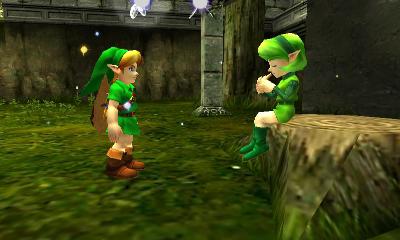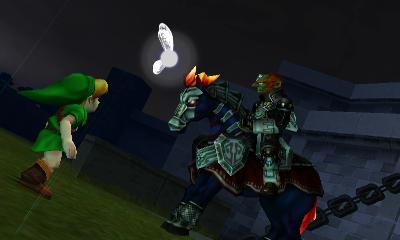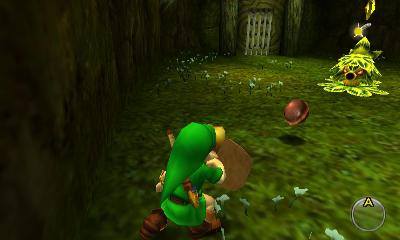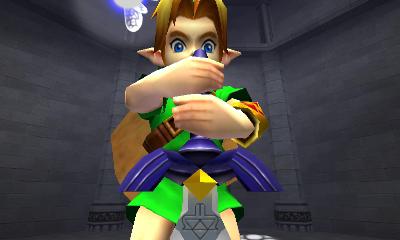
How does a person, in 2011, approach a review of The Legend of Zelda: Ocarina of Time? By what standards should you judge a game both universally hailed as one of the best ever made, and also now almost 13 years old? Difficult questions, but ones I could generally set aside once I sat down and actually dug into Nintendo's new portable version of Ocarina, gussied up in 3D. The original is a game I count among my all-time favorites but which I haven't touched since it was only a few days old. Today, the game holds up remarkably well, all things considered, and by sheer process of elimination it's practically a must-have for anyone who's already ponied up for the software-scarce 3DS.
Ocarina was inarguably a landmark when it released in 1998, and Nintendo has shown the game the right amount of reverence with this updated release. Not a port but not quite a remake, Ocarina of Time 3D boasts as its primary selling point a complete visual overhaul that brings the game up to 3DS standards--or at least, what I assume is indicative of the 3DS' capabilities, since we really haven't seen much out of this machine yet. You'd be forgiven if you took a cursory look at Ocarina 3D and thought it doesn't look much better than the Nintendo 64 original, but you'd be objectively wrong. That's just the rose-colored tint of nostalgia. Side by side, the new release looks leaps and bounds better than the old one, particularly the far more detailed character models. The world is full of cleaner, sharper textures and tons of lively new ambient effects as well. Top to bottom, it's a great overhaul. And while every person handles the 3DS' depth feature subjectively, this has been my best experience with the system's 3D to date. Hyrule's wide-open expanses and ornate interiors make a great showcase for the 3D effect, and I was able to play with the 3D slider most of the way up without my eyes ever seriously crossing.

In contrast to the thorough graphics upgrade, Ocarina 3D slavishly recreates every other aspect of Ocarina of Time, for better or worse. That's mostly for the better. Even now, over a decade later, the game's dungeons are still the real deal, full of devilish puzzles that challenge you to use the old Zelda item lineup in creative ways, intricate multi-level layouts, and no shortage of set pieces and architectural novelties. Remember stepping into the Forest Temple's twisted hallway for the first time? The passage of time hasn't much dulled the impact of such unexpected sights. Some of the dungeons are so complex, you get that almost overwhelmed feeling akin to the way you feel in games like Portal, where you have to step back and take it all in from a distance before you can decide how to start going about solving things up close. For a game this old to engender such a modern reaction is pretty impressive.
My prevailing memory of Ocarina focused on the sequence of those iconic dungeons. "Right... three dungeons as a kid, travel through time, five temples, done." But there's a good bit more content, most of it optional, around the edges of Ocarina to flesh out and enliven the game's version of Hyrule. Even having played the game in its day, I found myself stumbling onto some neat secret areas, finding unexpected pieces of heart, and so on, without immediately remembering where everything is. Ocarina of Time was one of the first games I remember that established a strong, coherent sense of place, and you still get a pretty great sense of that larger world as you explore Hyrule. There's plenty of value even for those who have been here before, though you're sure to recall certain things more clearly and immediately than others.

Ocarina's position in the video game pantheon is well-deserved, but there are a couple of spots where the age begins to show, where you wish devotion to recreating every aspect of the classic game might have given way to some thoughtful, modern-day refinements. The movement and combat work surprisingly well on the 3DS' controls, with a much appreciated option to toggle the enemy targeting by simply tapping the L button, instead of having to hold it down constantly. But it's hard not to miss the dual-analog camera control that underpins modern third-person action games, and the camera here tends to get hung up in tight spaces and make combat and some navigation a bit frustrating at those times. Also, early on in the game you'll spend an awful lot of time running back and forth across the sprawling Hyrule field, which itself doesn't contain much to occupy your attention. Later on there are enough ways to warp between locations this isn't much of an issue, and besides, I remember thinking the field felt a little empty way back in 1998 as well. There are probably fewer moments here where you remember this is an old game than there are in practically any other game of the era, but they do pop up.
Since this is, ultimately, a nice new coat of paint on the same game that came out last century, Nintendo's other few enhancements to Ocarina 3D bear mentioning. If you feel driven to go back and fight the game's bosses from a menu with a timer, you can do that. It's great that the game also offers the much harder Master Quest once you've completed the game the first time. There are some neat hint videos that apply to just about every area of the game, though none of them explicitly hold your hand through all of the puzzles. The best addition, besides the new graphics, is a pair of extra buttons on the touch screen that supplement the normal face buttons and let you map a couple of extra items. Even boots. (That means navigating the infamous Water Temple is as easy as tapping a button, rather than navigating multiple menus every time you want to access those infernal boots.) And while gyroscope-based motion control for aiming originally seemed like a bad idea to me, it actually comes in handy for precisely aiming projectile items like the hookshot and bow.

There are surely 3DS owners out there for whom Ocarina of Time 3D will be their first experience with one of the few classics important enough to truly earn the word "seminal." Those people should by all means stop what they're doing and go get this game. It's not the Zelda that established the series' traditional dungeon-item-dungeon-item formula, but it's the one that brought it into 3D space and (along with Super Mario 64 before it) and defined how pretty much every subsequent action game should work in 3D, as well. It's almost as important as a historical record as it is a game that's still enjoyable today.
For everyone else, your interest in this game should hinge on your interest in replaying a better-looking 3D version of Ocarina of Time, and unless you've replayed the old game to death in the recent past, this updated release serves as the best version to hold onto for posterity. If nothing else, Ocarina 3D is a sign of great things to come, because if the 3DS can pull off such a lovely rendition of this deep and deeply satisfying classic, just imagine what sort of new Zelda adventures the system might offer in the future.